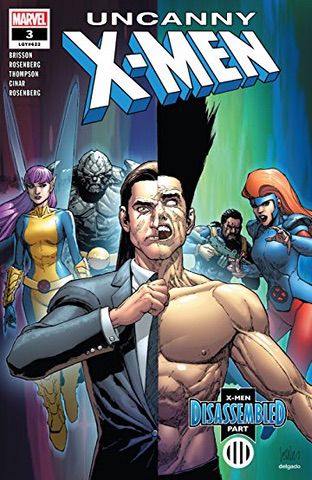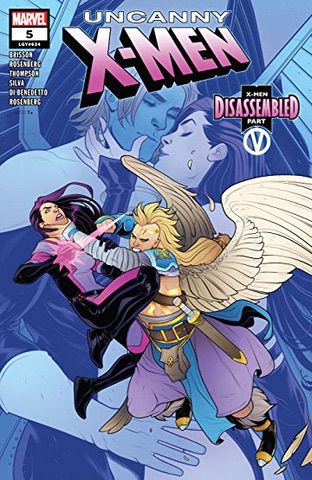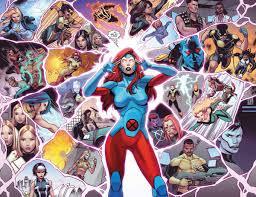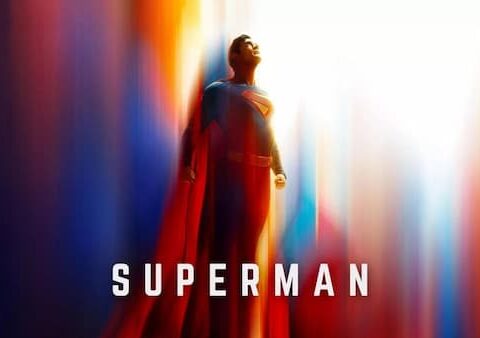As often proves to be the case, I sometimes feel like we’re in X-Men overload: in terms of how many different books and titles there are to try to keep track of.
There’s only so much time per month I can devote to reading comics – and keeping abreast of X-Men content right now is becoming like a full-time job.
So I didn’t particularly think we needed a new Uncanny X-Men book right now. X-Men Red has been really, really good: while X-Men Gold seems to be the ‘main’ book still. And there’s other X-titles going on right now that I haven’t even kept up with.
However, I was wrong.
This Uncanny X-Men run is pretty special: moreover, it’s chief purpose is to lead us all in to the ‘Age of X-Man’ event. That’s what all of these 10 books have been doing.
The thing I like most here is simply having all these characters come together. I always enjoy having this many X-faces unite – and this one’s got a lot of characters in the mix: not just obvious ones like Jean, Betsy, Hank, Laura, etc, but Cannonball, Polaris, Jubilee and a few characters that don’t always get to be in the limelight. It always makes it feel more like a family: and it always creates fun dynamics (the Jean/Bobby interplay in Uncanny X-Men #2, for example).
In regard to Uncanny X-Men #1, it’s really having all these guys in one story that’s what kept me engaged here. Jean getting Bobby onto the dinosaur mission is a beautiful moment.
There’s also good attention paid here to the young characters: and specifically how they resent being left on the sidelines by the grown-ups. So there’s a good range of dynamics here.
There is also a good sense of intrigue here: the mysterious crises building up here – changing weather patterns, extinct species coming back to life, the missing Kitty Pryde, etc – and the lack of known agency or force behind them. Still no one knows why Multiple Man is acting crazy; and the intrigue is doubled when Professor X’s mad son, Legion, shows up at the mansion at the end, appearing to Pixie, Armor, Glob and the kids and offering to “save the day”.
The intrigue continues to build in Uncanny X-Men #3. While the various X-Men are trying to deal with the crises in different locations, Legion is trying to get younger X-Men at the mansion on his side. But we learn Jamie Maddrox has been manipulated by Legion into his actions: Jean and co free Maddrox ‘Prime’ from captivity and they head back to the mansion to deal with Legion.

Which is when the mystery takes another turn: the unlikely quartet of Magneto, Angel, Blob and Omega Red show up, all sporting religious-type garb and with very altered personas (calling themselves the ‘Horsemen of Life, Wellness and Bounty’). They too claim to be saving the world: but they’re here to ‘end the X-Men’.
Just what the hell is going on?
In Uncanny X-Men #4, we peel back more of the picture. Nate Summers (‘X-Man’) is on an island somewhere, planning some kind of messianic event to save the world. He has Kitty prisoner, as well as Apocalypse (!). His powers are apparently off the chart, and he is in control of Magneto, Warren and the others.
I really love how this book opens: with Magneto and co thinking their attack on the x-mansion has actually killed all the X-Men – because Jean and Betsy are psychically projecting the image of all of their dead bodies. It’s a brilliant move – the characters survive, but their turmoil is only beginning.
But coming back to Nate Summers, all of this is laid on pretty thick. Openly presenting himself as a messianic saviour, he gives a psychic speech to the whole world, talking about taking action to save the planet: he even refers to himself as “the second coming” and talks about a ‘New World Order’.
It’s pretty blatant stuff, and Nate also looks (and is attired) entirely like an archetypal Jesus.
He also seems to be touching climate change and moving into ‘Agenda 21’ territory. That’s even more explicit in the next book, where we see Blob and Omega Red attacking an oil rig and ranting about the damage being down to Mother Earth.
Meanwhile the X-Men (and Legion) are watching Nate’s broadcast and trying to understand what has come to pass. Legion’s mini breakdown in this scene is really funny, as he tries to explain how he was trying to stop this and save everyone. But his unhinged manner makes it difficult for him to communicate non-manically: and Jean and Betsy end up psychically putting him to sleep.
This is fun stuff (Legion’s line about not trying to please your father is priceless), but it’s also very good writing: Legion feels responsible for the very existence of ‘X-Man’ because, as Bishop explains, it was Legion who created the ‘Age of Apocalypse’ reality in the first place – and ‘X-Man’ came from that reality and therefore is Legion’s creation.
What’s so good about that acknowledgement is that it means we’ve storytelling here that is spanning decades: I mean, I was literally about 15 when I was reading Age of Apocalypse back in 1995, and now – over twenty years later – I’m reading material that’s still following on from that and linked to it. Which is extraordinary.
It’s really a quality of writing that enhances one’s sense of connection or experience with the X-Men ‘saga’.
I always loved and was fascinated by all that material: the X-Men issues (X-Men #40 and #41, was it?) leading into the Age of Apocalypse, and the quest to stop Legion from killing Professor X. I also still have the four X-Man comics from the Age of Apocalypse, and re-read them every few years: so it’s gratifying to see the consequences of those events still playing out in contemporary books all this time later.
The tension between the younger X-Men and the grown-ups continues here too, and even tension within the younger group itself (specifically between Pixie and Armor). The tension is primarily caused by Armor’s perception that the elders are belittling them by treating them like children and continuously leaving them on the sidelines: but, in story terms, it becomes about the disagreement over what to do with Legion.
Jean and the others want to leave Legion under guard at the mansion, keeping him out of the equation, while Armor wants to use Legion to try to solve the crisis.
This is all good stuff too. It leads here, ultimately, to the kids deciding to take matters into their own hands and work with Legion behind the grown-ups’ backs.
The scale and apocalyptic nature of this storyline goes even further in Uncanny X-Men #5, when X-Man takes Apocalypse’s advice and wipes out the places of ‘false worship’ and ‘false prophets’ in the world, including Mecca in Saudi Arabia and the Vatican.
It’s kind of extraordinary that this story is going there: but it certainly raises the sense of scale and stakes. X-Man’s powers are off-the-charts.

On the other hand, I feel like Apocalypse himself has been poorly written here: his dialogue just doesn’t read like stuff Apocalypse would say. Maybe even the idea of him being Nate’s prisoner doesn’t feel right either: but more so it’s the dialogue, which just doesn’t seem to fit his character.
On the other other hand, it’s clear now what Nate is holding Apocalypse, Kitty and Senator Allen hostage for an interesting reason: they are his ‘council’. He literally wants their guidance and advice: a role that Kitty is unwilling to play here, but which Apocalypse is happy to indulge in – leading to the aforementioned elimination of the Vatican, the Kaaba and other holy sites around the world.
Meanwhile the confusion and uncertainty grows when it turns out that the facility that Blob and Omega Red attacked has been transformed into some kind of nature-friendly paradise. The sequence of Jean and co wandering around this sea of green and vegetation is one of the more interesting turns in the story, beginning to indicate that what X-Man is doing might not be without some degree of beauty to it.
Elsewhere, we get two good confrontations: between the altered Magneto and his daughter Polaris, and between Betsy and the altered Warren. In both cases, these are fights between people who have a meaningful connection and so the material is more engaging than if it had been just random showdowns.
In Uncanny X-Men #6 we see the fall-out between Betsy and Warren – in trying to break him out of X-Man’s control, she has reverted him to his Archangel form. He is nothing but resentful, even going so far as to complain that Nate had given him peace for the first time in his life and Betsy has now taken that from him. It’s good to see attention paid to these two characters and their relationship in the midst of all this larger storytelling – it’s an element that, in other book, might’ve been overlooked or glossed over. But here it’s given the attention it warrants.
The story builds to the various X-Men locating X-Man’s awesome-looking base (or temple) to confront him. Here, we learn an additional aspect of Nathan’s motivations: he is dying. And he wants to make everything right in the world before his time is up. With no breakthrough between him and the X-Men, he moves against them: but Armor, Pixie, Legion and co arrive on the scene.
For a moment, it seems as if Armor – unlike Jean – is actually getting through to Nate on some level. This seems like it’s going to be the vindication of Armor and the kids after all the tension and disagreements with the grown-ups: except it isn’t. Legion loses patience and acts rashly… and, seemingly, creates an alternate reality.
We immediately see characters looking different: different costumes and appearances. What is this? Has David created another Age of Apocalypse? Surely not.
Onto Uncanny X-Men #7 and yes, that’s precisely where we are. We immediately join Armor, Glob and co in an alternate reality that very much resembles the Age of Apocalypse. X-Man is here too, returned to a nightmare reality – his plans have failed and Legion has outmaneuvered him.
What’s clever about this installment is the total absence of the major X-Men characters – there’s no Jean or Ororo, Kurt or Betsy, etc. Just the X-Man and the kids – Armor, Pixie, Glob and Rockslide – trying to figure out how to get back to their reality. We see that the kids have already split into two opposing groups – Pixie and Glob in one, Armor and Rockslide in the other – with each having a radically different view of how to fix this problem.
Pixie wants to kill X-Man here in the Age of Apocalypse, so that he can’t get back to their Earth and resume his plan: Armor, however, sees X-Man as the only way out of the AoA and back to reality. In the end, however, we see Armor convinced over to Pixie’s view and preparing to put Nate out of his misery.
What’s great about this chapter is the total ambiguity and mystery: where are ‘our’ X-Men, where is the prime reality? It isn’t answered. All we see is these guys stuck in the AoA – and that’s all. There’s also an ambiguity over how much time has passed: Nate even references this – has it been weeks? Months? Years? Nate’s horror at being back in this reality again is also perfect.
The quality and intensity carries on in Uncanny X-Men #8, where we immediately get a better perspective on what’s going on.
Legion has placed the kids and X-Man into a mental version of the Age of Apocalypse. We now see what’s going on in our reality, from the elder X-Mens’ perspective, as they try to figure out both what’s going on and what to do about it.
The conflicting approaches that quickly emerge are interesting, and all in keeping with what we know about these characters. Bishop – the only one who knows and experienced the Age of Apocalypse – absolutely wants to find a way to get the kids out of the warped reality Legion has put them into. Kitty, on the other hand, has reservations about that. And Apocalypse wants to take it on himself to kill both Legion and X-Man, stranding the kids, but saving the planet.
The one quibble would be that having Apocalypse here at all still feels incongruous: but I’m letting that go. Betsy psychically helps Bishop get into Legion’s mind – his Age of Apocalypse mental recreation – so he can finds the kids.
A few plot-points later, the kids seemingly return to our reality with Bishop (Pixie’s “Holy crap! Apocalypse!” is perfect): but Legion’s reaction indicates an immediate new problem.
What’s also pretty awesome about this whole thing with Pixie and the others trapped in a version of the Age of Apocalypse is that it is clearly foreshadowing what it is to come several chapters down the line, with the ‘Age of X-Man’.
Uncanny X-Men #9 quickly reveals that Bishop had tried to contain X-Man within Legion’s mind: but the plan backfired and Nate has instead taken over Legion’s mind and body entirely. What unfolds next is a battle royale between the X-Men and an unhinged and angry X-Man/Legion.
There’s not much to say about this – other than that it’s all very good stuff. As action-centered books go, this is all done very well and feels like a quintessential X-Men rumble.
There are a few good twists too: Ororo being taken over by X-Man/Legion and made into one of his ‘horsemen’ or Jean using Pixie to bring in reinforcements from all corners of the X-Men world.

As climactic finales go, Uncanny X-Men #10 is a knock-out.
With the reality-shattering confrontation between the X-Men and Legion/X-Man raging, everything comes to a head. When it comes to huge teams of superheroes battling an all-powerful villain, these thing can get tedious very quickly, being pretty cliched: but Uncanny X-Men #10 avoids that problem entirely.
It does this, firstly, by paying due attention to its many characters and incorporating them into the conflict in meaningful ways, and secondly by building everything to a really significant, earth-shattering conclusion.
On that first point, what I loved most about all of this life-or-death action was the attention paid to characters: and not just the ‘main’ characters. There’s a ton of x-characters in this story, but this book doesn’t lose track of any of them.
From Psylocke and Archangel working together to the Stepfords’ playing a pivotal psychic role to the final struggle being between Jean and Nate inside Nate’s mind, the writers effectively show great care for the personalities and powers in their case.
Matthew Rosenberg, Kelly Thompson and Ed Brisson deserve a ton of credit for this: because it’s something a lot of big-scale events in comic books often get wrong.
Heck, even Sam and Paige Guthrie get some limelight. I was thrilled, at that, to see Paige Guthrie show up here – I haven’t seen that girl in ages.
At any rate, what everything builds to is the extinction of the X-Men. About to be overcome by his opposers (including even the likes of Magneto, who has been freed from Nate’s control), Nate’s final maneuver is to use his (and Legion’s) powers to create a reality in which the X-Men no longer exist.
Jean fails to stop him. It is Nate’s final act before – it appears – he dies, alone in a wilderness. We fade to black.
And then we briefly see a world made anew: as the mysterious figure (Scott Summers, it seems) narrating to us explains, X- Man has eliminated the X-Men from this world’s existence – and the world celebrated. In a rather eerie ending, we’re shown that mostly everything in the world rolls on as normal, and you almost wouldn’t notice anything was different.
The anti-mutant vaccine has been rolled out immediately, allowing society to prevent new mutants from emerging.
That’s where we finish: with a hell of a lot of questions. ‘Where’ are the X-Men? Is it total non-existence… or is there a catch? Is that Scott Summers? What role is he to play now in this complex situation?
Age of X-Man: Alpha looms next – with some somewhat familiar-feeling x-title reboots to follow. And it’s pretty clear that the new Age of Apocalypse is upon us. But, for now, Uncanny X-Men #10 is a stunningly good finale to this long story arc.
It does so much right, practically nothing wrong, and serves as such a worthy bridge between the one state of affairs to the next. It has tension, it has climax, it has mystery even at the end: and, most of all, it has solid character work that is mostly so well in-keeping with these characters and with X-Men history.
You can’t ask for much more than that.
If I have one quibble, particularly with this climax in Uncanny X-Men #9 and #10, it’s a fan-boyish one. Beginning with WHERE WAS ROGUE? Proceeding to WHERE WAS GAMBIT? And with a touch of WHERE WAS ILLYANA? That list could probably be longer. Wait, are Rogue and Gambit still out in space at this point in the chronology (in ‘Mr & Mrs X‘)? I guess that must be it. I also feel a bit iffy about the way Magneto has been written in this series: essentially as a non-entity, a mind-controlled lackey for X-Man.
But really, those are my only complaints: and I can pretty much let them go, given everything else.
This whole run of Uncanny X-Men leading up to this ‘Age of X-Man’ event has been superb. I was actually doubtful this title would manage to be as consistently good as the X-Men Red series: but it is more than equal to it, if not better.
In the broader strokes, I have to say that these two books – Uncanny X-Men #1 – 10 and X-Men Red #1 – 11 – have restored my enthusiasm in contemporary X-Men comics at a time when it was really waning after many months of poor books and sub-par storytelling.




